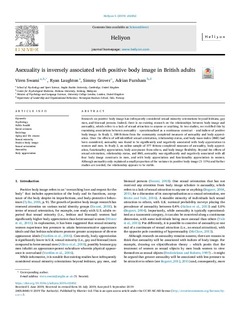| dc.description.abstract | Research on positive body image has infrequently considered sexual minority orientations beyond lesbians, gay men, and bisexual persons. Indeed, there is no existing research on the relationships between body image and asexuality, which refers to a lack of sexual attraction to anyone or anything. In two studies, we rectified this by examining associations between asexuality – operationalised as a continuous construct – and indices of positive body image. In Study 1, 188 Britons from the community completed measures of asexuality and body appreciation. Once the effects of self-identified sexual orientation, relationship status, and body mass index (BMI) had been considered, asexuality was found to be significantly and negatively associated with body appreciation in women and men. In Study 2, an online sample of 377 Britons completed measures of asexuality, body appreciation, functionality appreciation, body acceptance from others, and body image flexibility. Beyond the effects of sexual orientation, relationship status, and BMI, asexuality was significantly and negatively associated with all four body image constructs in men, and with body appreciation and functionality appreciation in women. Although asexuality only explained a small proportion of the variance in positive body image (3–11%) and further studies are needed, the relationship appears to be stable. | nb_NO |

